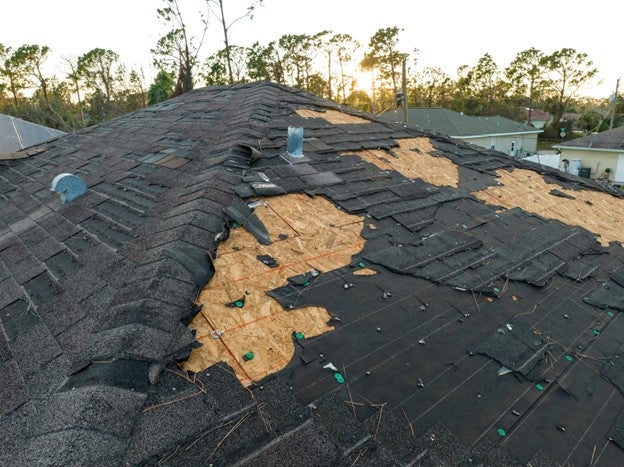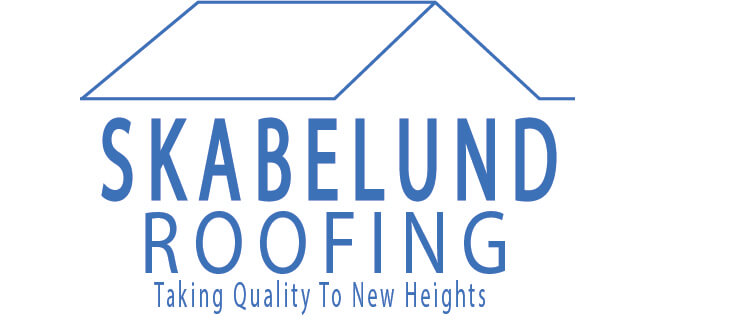Navigating Roof Storm Damage: A Comprehensive Guide
In the aftermath of a storm, homeowners face the daunting task of assessing the impact on their homes, with the roof often bearing the brunt of the damage. Whether it’s the relentless pummeling from hail, the tearing force of high winds, the insidious infiltration of water, or the blunt impact of falling debris, the integrity of a roof can be severely compromised during a storm. Understanding the nuances of roof storm damage is not just about identifying the visible signs of distress; it involves recognizing the potential for hidden damage, knowing when to seek professional assessment, and navigating the often-complex process of filing insurance claims for repairs or replacement.
Today we’ll talk about how to navigate the aftermath of roof storm damage effectively. It will delve into the common types of storm damage roofs can sustain, the indicators of such damage, and the immediate steps to take following a storm. Additionally, the guide will provide practical advice on conducting preliminary assessments, the critical role of professional inspections in identifying both apparent and underlying damage, and the essential considerations for making temporary repairs to prevent further damage.
Moreover, understanding the intricacies of insurance policies and the claims process is important in securing the financial assistance needed for repairs or replacement. This guide will offer valuable insights into dealing with insurance claims, including tips on documenting damage, filing claims, and maximizing insurance payouts. By demystifying the process and highlighting preventative measures, homeowners will be better prepared to protect their homes against future storms and ensure the longevity and safety of their roofs.
Understanding Roof Storm Damage
Roof storm damage can manifest in various forms, each with its unique implications for the integrity and functionality of a home’s roofing system. Understanding these different types of damage and their potential impact is crucial for homeowners to make informed decisions about repairs, insurance claims, and preventive measures.
Types of Roof Storm Damage
- Hail Damage: Hail can cause bruising, cracking, or even puncturing of roofing materials. Asphalt shingles may lose granules, leading to accelerated aging, while metal roofs might exhibit dents. The severity of hail damage often depends on the size of the hailstones and the duration of the hailstorm.
- Wind Damage: High winds can lift or completely remove shingles, expose the roof deck to the elements, and lead to water infiltration. The damage might be localized to certain areas, especially along the roof’s edges, or it can be widespread, depending on the storm’s intensity.
- Water Damage: Heavy rains can exploit any weakness in the roofing system, leading to leaks and water damage. Over time, this can result in mold growth, rotting of the roof deck, and compromised structural integrity. Water damage is often more insidious, as it may not be immediately apparent.
- Debris Damage: Storms can hurl branches, rocks, and other debris onto roofs, causing immediate physical damage. This might include cracked or broken tiles, punctured roofing membranes, or damaged gutters and flashing. Debris can also obstruct water flow, leading to pooling and further water damage.
Signs of Roof Storm Damage
- Visual Indicators: After a storm, visible signs such as missing shingles, dents on metal surfaces, cracked tiles, or debris accumulation on the roof can indicate damage. It’s also important to check for granule loss in gutters and downspouts, as this may signal significant shingle damage.
- Structural Compromises: Warping, sagging, or other distortions in the roof line suggest more severe structural damage. Inside the home, look for new water stains on ceilings or walls, which can indicate a compromised roofing system.
- Interior Signs: Water leaks in the attic or along the ceiling are clear indicators of roof damage. It’s also wise to check for daylight through the roof boards, as this can suggest missing shingles or larger breaches in the roof’s surface.
Immediate Steps Post-Storm
- Safety First Approach: Prioritize safety by avoiding any immediate inspection of the roof during a storm or if there are risks of electrical hazards or structural instability. Wait until it’s safe to proceed.
- Temporary Measures to Prevent Further Damage: If safe and feasible, temporary measures such as applying tarps or securing loose elements can help minimize additional exposure to the elements. This is particularly important to prevent water infiltration before permanent repairs can be made.
- Documentation of Damage: Taking photographs and detailed notes of any visible damage is crucial for insurance claims and for professionals to assess the extent of repairs needed. Document everything from different angles and include any debris that may have caused damage.
Assessing Roof Storm Damage
Navigating roof storm damage involves a careful balance between immediate action to prevent further damage and strategic planning for long-term repairs. By understanding how to assess damage, when to involve professionals, and how to manage repairs, homeowners can effectively protect their homes and ensure their roof’s longevity.
DIY Inspection Tips
- Safety Considerations: Always prioritize safety. Use a sturdy ladder, wear non-slip shoes, and consider using a safety harness. Never inspect a roof alone; ensure someone knows you’re performing the inspection.
- Tools and Equipment Needed: Equip yourself with a camera or smartphone for photos, a notebook for observations, binoculars for a closer look from the ground, and a flashlight for attic inspections.
- Step-by-Step Guide for Inspecting Roof:
-
- From the Ground: Use binoculars to survey the roof for missing shingles, visible dents, or debris. Note any damaged areas.
- Gutter and Downspouts: Check for shingle granules—a sign of shingle wear—and any blockages or damage.
- Attic Inspection: Look for signs of water penetration, such as wet insulation, stained wood, or mold. Use a flashlight to check for daylight through the roof.
- On the Roof: If safe, walk the roof to inspect for damaged or missing shingles, dents in metal parts, or cracked tiles. Pay special attention to vents, chimneys, and skylights.
When to Call Professionals
- Benefits of Professional Roof Inspections:
- Professionals can identify not just obvious, but also subtle damage that may lead to problems later.
- They have the expertise to assess structural issues that might not be apparent to the untrained eye.
- Professional inspections can provide documentation needed for insurance claims.
- How to Choose a Reputable Roof Inspector or Contractor:
- Look for licensed, insured professionals with good reviews and recommendations.
- Verify credentials and ask for references.
- Choose someone experienced with storm damage assessments and repairs.
- Understanding the Roof Inspection Process:
- A comprehensive inspection will cover both the exterior and interior of the roof.
- Inspectors use specialized tools, such as drones or moisture meters, to assess damage.
- They provide a detailed report with recommendations for repairs or replacement.
Handling Roof Storm Damage
After assessing the damage, the next steps involve making immediate repairs to prevent further damage and planning for long-term solutions.
Immediate Temporary Repairs
- Temporary Fixes to Minimize Water Infiltration:
- Apply tarps over damaged areas securely, using boards or nails to hold them in place.
- Seal leaks around vents or chimneys with roofing cement or caulk as a temporary measure.
- When and How to Tarp a Roof:
- Use tarps if expecting more rain or delays in repair. Ensure the tarp covers the damaged area completely, extending over the roof’s peak.
- Secure the tarp with 2x4s, nailing them to the roof or using heavy-duty adhesive to prevent wind lift.
Long-Term Roof Repair Solutions
- Deciding Between Repair and Replacement:
- Consider the age of the roof, the extent of damage, and future storm protection needs.
- Minor, localized damage might be repairable, but widespread or severe damage may necessitate a full replacement.
- Material and Contractor Selection:
- Choose materials suited to your climate and designed to withstand future storms.
- Select a reputable contractor with storm damage repair experience, verifying licenses, insurance, and references.
- Timelines and Expectations for Roof Repairs or Replacement:
- Discuss timelines with your contractor, understanding that weather and supply issues can cause delays.
- Set realistic expectations for the completion of repairs or replacement, keeping communication open throughout the process.
Dealing with Insurance Claims for Roof Storm Damage
Navigating the insurance claim process for roof storm damage can be challenging, but understanding your policy and knowing the steps to file a claim can significantly ease the process. This section provides insights into handling insurance claims, from understanding your coverage to maximizing your claim.
Understanding Your Insurance Policy
- Coverage Types and Limitations:
- Familiarize yourself with the specifics of your policy, including what types of storm damage are covered and any exclusions or limitations. Policies typically cover damage from wind, hail, and the like, but the extent of coverage can vary.
- Understand your deductible—the amount you pay out of pocket before insurance coverage kicks in—and how it affects your claim.
- Deductibles and Claim Process Overview:
- Review how your deductible applies to storm damage claims. Some policies have separate deductibles for specific types of storm damage.
- Know the steps required by your insurer to file a claim, including any deadlines or documentation requirements.
Filing a Roof Damage Claim
- Gathering Necessary Documentation:
- Compile evidence of the damage, including photos, videos, and a detailed list of affected areas. Documentation should be thorough and organized to support your claim.
- Keep records of communications with your insurance company, including dates, names, and details of conversations.
- Tips for a Successful Claim Submission:
- Report the damage to your insurance company as soon as possible. Prompt reporting can expedite the claims process.
- Provide all required documentation and information with your claim submission to avoid delays.
- Navigating Insurance Adjuster Inspections:
- An insurance adjuster will inspect the damage to assess the claim. It can be beneficial to have your contractor present during the inspection to ensure all damage is noted.
- Discuss your contractor’s findings and any discrepancies with the adjuster’s assessment to ensure a fair evaluation.
Maximizing Your Insurance Claim
- Key Points for Negotiating with Insurance Companies:
- If the settlement offer from the insurance company seems low, review it against your contractor’s estimate and your policy’s coverage. You have the right to question and negotiate the claim amount.
- Provide additional documentation or a second opinion from another professional if necessary to support your case.
- Using Professional Estimates in Your Favor:
- Professional repair estimates can serve as powerful evidence in supporting your claim amount. Ensure that the estimates detail the scope of work and costs involved.
- Compare the insurance company’s assessment with your contractor’s estimates to identify any discrepancies or overlooked damages.
- Handling Disputes and Rejections:
- If your claim is disputed or rejected, request a detailed explanation from the insurer. Understand the reasons behind their decision.
- Consider appealing the decision if you believe the claim was unjustly denied or undervalued. You may also seek assistance from a public adjuster or legal advisor specializing in insurance claims.
Dealing with insurance claims for roof storm damage requires patience, organization, and persistence. By understanding your policy, preparing thorough documentation, and effectively communicating with your insurance company, you can navigate the claims process more smoothly and ensure you receive the compensation you deserve to repair your home.
Skabelund Roofing Can Help
If your home has sustained storm damage, call Skabelund Roofing. Our experienced professionals are always standing by to provide you with free advice and estimates on how best to manage your repair project. We can even help you navigate your insurance claim difficulties. With over 25 years under our belts in service to the Cache Valley, we have seen it all. Whether you need inspection, roof strengthening, repair or installation, we are the partner you can trust to do the job right. Contact us today!
